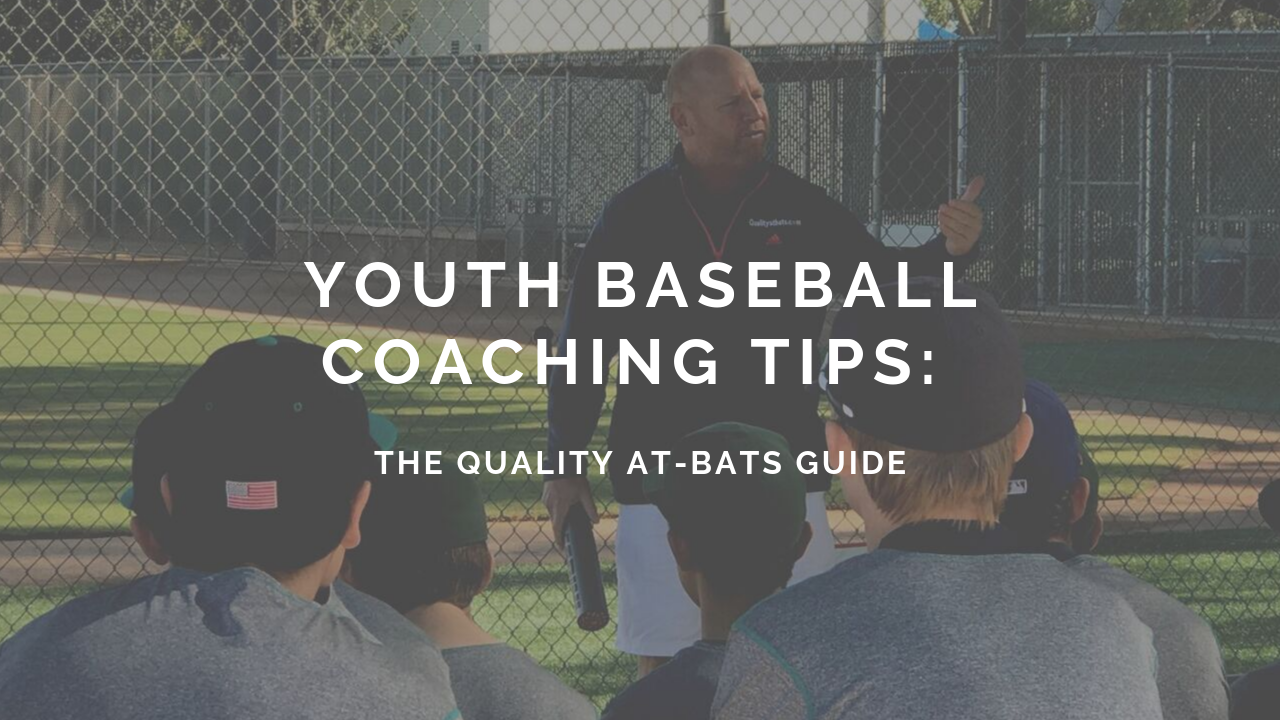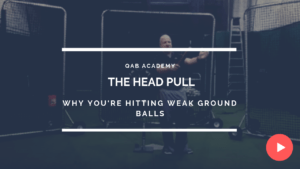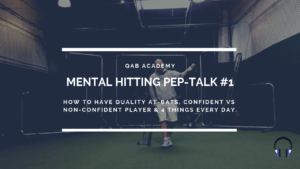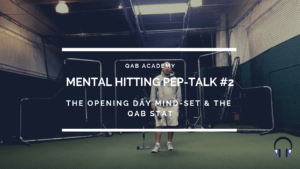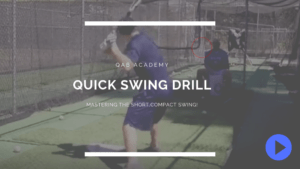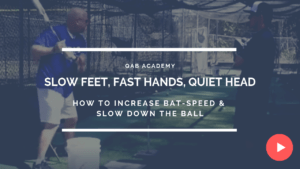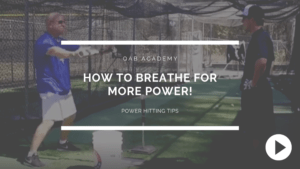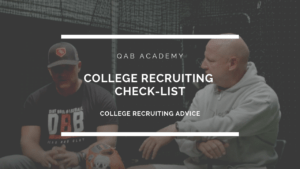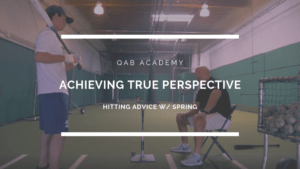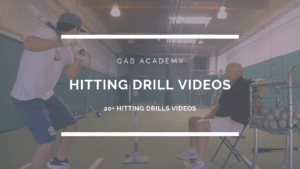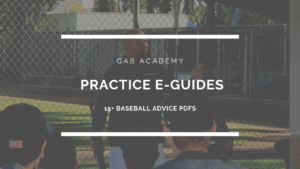Youth baseball coaches here's a tip, you're not gonna be the next Tommy Lasorda coaching your youth 12U baseball team. We have to keep it fun. If you have any questions about this Youth Baseball Coaching Tips: The Quality At-Bats Guide, please post it in the comments below or on our Facebook News Feed
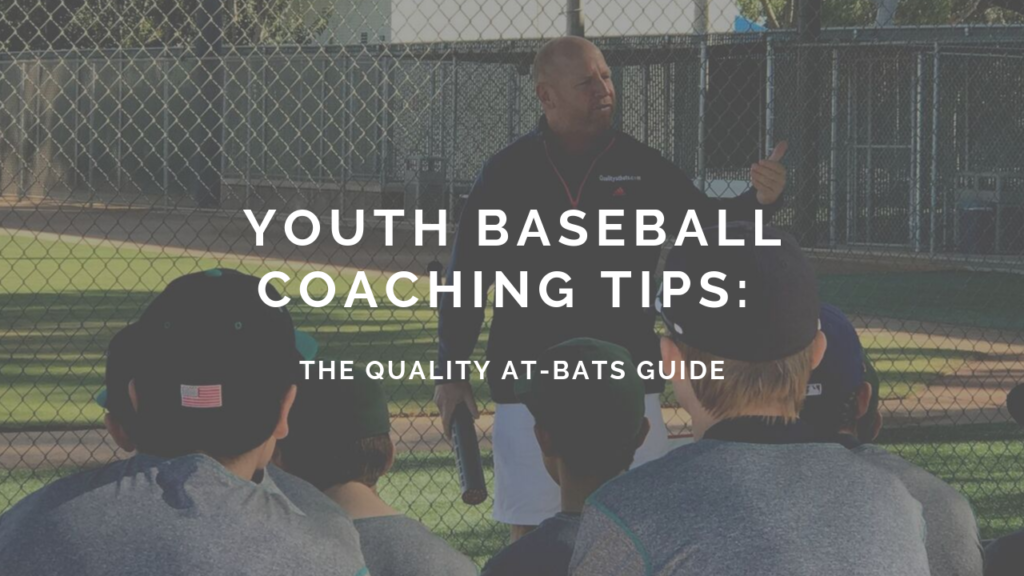
The foundation of youth baseball coaching starts with making the experience of playing for your team, fun.
Vanderbilt University isn't gonna care if your team won the Burger King Championship and the only thing that's gonna matter is how effectively you used baseball as a tool to help your players become responsible adults. Period.
As my buddy once said:
Baseball is nothing more than another classroom in the educaional process. Really, baseball is a metaphor for life.
Auggie Garrido
In this Youth Baseball Coaching Tips: The Quality At-Bats Guide, we're gonna discuss:
- Building Them Up
- Building Instincts
- Hunting Pitches & Selective Aggressiveness
- Attacking The inner half of the ball
- Approach Over Mechanics
- Building a Controlled Violent Swing
- Getting Rid of the Batting Average
- Building an Opening Day Mind-Set
Build Them Up
Look, I get it. Kids need to be held accountable, but if you're a coach and you yell at a 12-year-old or under, you're not coaching them you're humiliating them in front of their peers.
Quality coaching is about building your players up, breaking them down and then building them up again.
When you praise them, praise them in front of their teammates. When you get on them, bring them to the side.
As coaches, it helps to guide your players to build a positive circle of people that give them permission to NOT be perfect but also to never stop striving to get better.
Looking back, I'm so glad I didn't listen to the negative people and coaches who told me I wasn't good enough when I was in high school and my first year in college baseball to reach my dream of playing in the big leagues.
Building Instincts
When I was a cross-checker for the Diamondbacks, I would go to a game to see a prospect.
The first thing I would do before setting up is walk over to the player's coach and ask him about the player's instincts. If the coach "fudged" even just a little, I couldn't vouch for the kid. I would pack up my things and head back home.
Seems harsh - but here's the truth. Playing baseball at a high level is hard enough with instincts. It's impossible to excel without them.

Your players are guaranteed to underachieve if you don't take the time to help your player develop their baseball I.Q....and they don't have to be the next Mike Trout to have great instincts.
It starts with understanding the approach, the mental side and learning how to compete.
This is why I say playing multiple sports is great. It helps ballplayers learn how to compete.
As a coach, in my opinion, your focus should be on the approach, the mindset and then the mechanics.
The right approach cleans your mechanics and without them, they'll lose their confidence.
Hunting Pitches & Selective Aggressiveness
A 92-94 mph fastball looks like a water balloon when you see it every day. Bring that guy on. It's the pitcher who can sink it, spin it and locate it that's tough to hit.
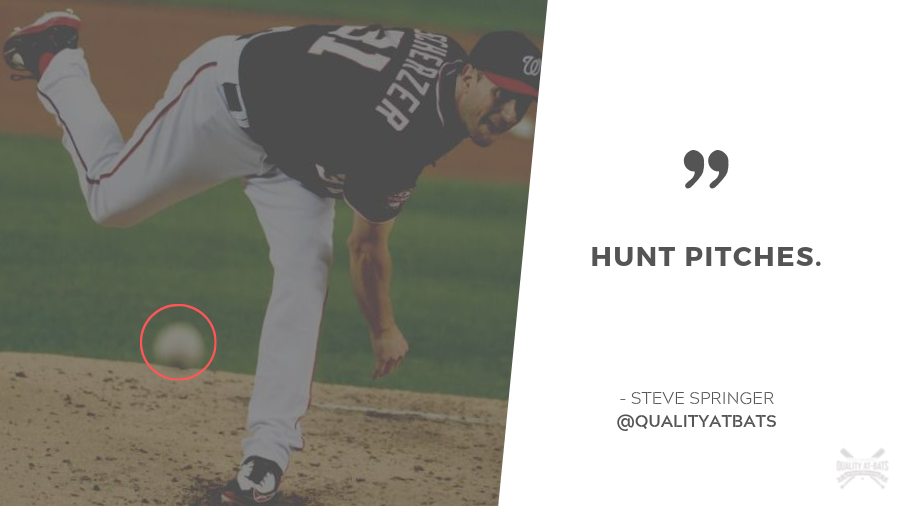
Coaches, there are two common reasons hitters underachieve at the plate.
First, hitter's aren't studying the pitcher.
Here's a question. Is it easier to hit one pitch when you know it's coming or three when you don't?
Stupid question right? Then why are hitter's trying to hit the fastball, curveball, change up 0-0? Swinging at everything, not looking for anything?
It's because they're trying to swing at what they want to hit instead of what they're going to get.
I can almost guarantee you if a hitter isn't ready to hit, it's because they're not watching the pitcher and hunting pitches.
How many at-bats do I believe a hitter gets a game? Five? Nope. 20.
Five on his own and another 15 while he's watching his buddies hit. The pitcher is the test, and he'll tell you what he's going to throw the next hitter by what he's throwing the current hitter.
Secondly, there are always two ways to swing a bat.
With or without an approach.
Passively or aggressively.
To make contact or to drive the ball with authority.
Often times, I see young hitters swinging at pitches to NOT miss instead of to drive the ball hard somewhere...
...and I can spot it from a mile away.
They're also thinking, I'm going to swing "IF" it's a strike instead of "it's going to be a strike, and I'm not gonna miss it!"
Eventually, you're going to see guys on the mound who throw harder with better control.
Most of these guys will have two or three pitches they can throw for a strike.
You're going to have to be able to make adjustments quickly and you're going to have to be ready for the fastball.
If I tell a hitter "here comes the fastball" and they can't put a good swing on it...they should go play soccer. 😉 Joking. Sorta.
Hitters have to be ready to hit. They have to watch the pitcher and they have to hunt pitches if they want to string together Quality At-Bats throughout the season.
Attacking The Inner Half of The Ball
When I'm offering hitting advice, the same things I say to a major league all-star is the same thing I say to the dad of a 12-year-old.

When it comes to the mental side of hitting I touch on the:
- Opening day mentality
- Getting rid of the batting average
- Being a better competitor than you are a ballplayer.
Meanwhile, when it comes to mechanics and approach I talk about "attacking the inside part of the ball".
Ultimately, when you're pulling balls that shouldn't be pulled, you get the weak ground ball to the pull side.
See - hitters like Josh Donaldson, Mark Trumbo or David Ortiz...
...they have OFF THE CHARTS power. They can hit it out of the ballpark like it's nothing.
So why don't they hit a home-run every, single at-bat?
Well, it's because sometimes they make contact with the wrong side of the ball.
Sure - no one is going to hit a bomb every time, but you can't tell me that these guys aren't great a showing up to the plate with confidence while attacking the INSIDE part of the ball.
Most hitters get themselves out not because they were outmatched but because they were trying to pull pitches that they have no business pulling.
In the photo above, I show you exactly where you should attack the baseball if you're a right-handed hitter.
If you're lefty, then the point of contact is on the other side.
I call it the green side of the ball.
Once you learn how to attack this part of the ball, watch your ability to hit the ball HARD sky-rocket and your confidence rise along with it.
Approach Over Mechanics
Ever watch Moneyball? Well, he was at my wedding. Billy Beane, not Brad Pitt. This is us back in 1984. Jeff Innus on the left. Me in the middle and Billy Beane on the right.
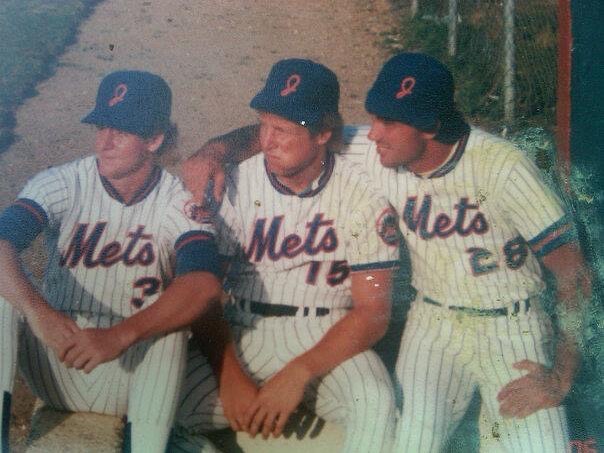
Billy Beane was one of the most talented players I had ever played with. He could run, he could hit, he had a cannon for an arm. If he had as good of a mental game as he had power and speed, he'd be in the hall of fame as both a player and as a GM.
This is why I've said the approach and the mental side is so important.
I believe the right approach cleans up mechanics.
This is about having slow feet, fast hands, and a quiet head so you can take a good, controlled violent swing.
Also, I believe when your focus is on being a great competitor instead of getting a hit, things fall into place for you on the field and in the batter's box.
Approach. Mentality. Mechanics.
I'd rather have nine guys in the line-up with the right approach and decent swing than nine guys with the wrong approach and perfect swings.
Too many players are swinging a $300 bat with a $1 approach.
I walk into a baseball clubhouse full of inspired baseball parents, players and coaches...
...I'm ready to talk some hitting and the first question that gets asked is, "how come my son's swing breaks down so quickly?!"
When a hitter struggles, what is the first thing we tend to fix?
What advice do we tend to give?
We tend to look at:
The stance. ("Open up your stance and bend your knees")
The swing. ("Get on top of the ball. Swing earlier")
The level of effort. ("Try harder. Concentrate!")
I'd say in about 90% of these cases, the advice above is either flat out WRONG or missing the mark by a whole lot!
In almost all cases, when a hitter is struggling, it's because of the WRONG approach to hitting.
I've often said, "if you want to fix your swing, make sure you have the right approach. The right approach will fix mechanics".
Never forgot, hitting is approach, mentality and then the mechanics.
In that order. Almost every time.
If and when you or your kid is struggling at the plate, make sure that you begin with the right approach.
Too Many Players Are Swinging a $300 Bat With a $1 Approach.
- sTEVE spRINGER
Building a Controlled Violent Swing
You’d be surprised how important mindset is in having an effective swing.
So many hitters want to learn how to hit for power. As a coach, you got to get them to the point of being a great hitter first. Power comes later.
Hitting with controlled violence means you’re swinging with a strong intent to hit the ball hard.
You’re swinging to drive the ball hard instead of swinging to just make contact or to "NOT" miss.
Very BIG difference.
Hitting isn't violent, violent and it isn’t controlled, controlled.
It’s controlled violence...
…w/ an attainable goal to hit the ball hard.
Teach your hitters to swing with controlled violence.
Getting Rid of The Batting Average
STATS, STATS, STATS!! We get so consumed with STATS! As youth baseball coaches we need to help our players to get consumed with competing with confidence every day, instead.
Stats are yesterday! They have no value in the most important game of the year which is today's game.
Here's the main point, coaches.
Players playing with tension, anxiety and pressure play that way because they're making it about them and their stats.
Trust me, when you're making it about helping your team win, the pressure and anxiety goes away.
Never forget this, the Batting average is EVIL. I call it SATAN in my Quality At-Bats CD.
The million-dollar question is, "how can you have a goal where you do everything right and still go 0-4?"
That makes no sense!
That is why training the mental side of hitting is so important.
Counterintuitively, when our goal is to get a hit or when our goal is the batting average, we start focusing on things we can't control, so we lose confidence.
Not anymore. We need to learn how to get out of our own way.
This means getting great at showing up with confidence with an attainable goal to hit the ball hard and help your team win.
When your goal is on helping your team win...
...when your goal is to hit the ball hard, the confident player within you will show up. I guarantee it.
We all have two players within us. Confident player and non-confident player.
The non-confident player isn't very good. A confident player is great.
Let's get great at competing with confidence for 9 innings.
The batting average has no brain...
It doesn't know if you're walking up to the plate with confidence or without it.
It's always going to be there.
I'm here to help you achieve your highest batting average believe it or not by getting the confident hitter to show up every single at-bat.
Building an Opening Day Mind-Set
As a coach, I loved players that I knew were going to be the same player every day. A player who's competing with confidence to help the team win.
At the end of the day, what you really want to help players be known for is being labeled as:
- Grinders
- Gamers
- A player w/ instincts
- Great on both sides of the field
- A Great teammate
- A player who makes their teammates better
All of these traits require zero talent. It's a choice, and it can be taught.
Here's what we know. Baseball is a game of inches. So then why don't we focus more on the details? Instead of launch angle, exit velocity and our slugging percentage...why aren't we focusing more on our level of "competing"
If we know that hitting is 90% mental, why do we practice it less than 10% of the time?
If know we're good when we're confident, how do we walk up to the plate with confidence with every single at-bat?
These are all important questions worth answering.
I believe that I spent 14 years in the minor leagues to help players answer these types of questions...
...and to help players get out of their own way.
If I could give your players one mental hitting adjustment and one hitting drill, here's what they would be.
1. Change what you think success by creating daily attainable goals. (This is where confidence comes from.)
2. Master attacking the inside part of the baseball. (which we already talked about.)
To practice changing what you think success is, you need to train the mental side of hitting. This is how you hit with calmness, toughness, and focus.
When you combine competing with confidence for three hours with an approach of attacking the inside of the baseball, you just gave yourself a recipe for success.
If you LOVE your abilities but your abilities aren't showing up, it's not your abilities fault.
Adopt the right approach and get that mind right...
The right mindset produces better effort. Effort beats talent, especially when talent doesn't show up.
In all, I really hope you enjoyed the Youth Baseball Coaching Tips: The Quality At-Bats Guide.
If you want to take your coaching knowledge up and level, here are some "Best Of" Quality At-Bats articles.
- Baseball Pitch Recognition Tips & Tricks
- Two Reasons Why You’re Late on Pitches
- How To Stay Calm At The Plate
- Youth Baseball Coaching Mistakes
- The Ultimate Baseball Hitting Tip.
- Youth Baseball Motivation – How To Encourage Ballplayer’s Development While Keeping Perspective.
- 2 Advanced Hitting Approach Tips
- The Mental Side of Hitting A Baseball
- How To Deal With Batting Slumps.
...If you want to get to hitting with better pitch recognition and confidence FASTER, join over 3,000 hitters who are training their mental side of hitting, bat-speed and hitting I.Q. in the >>> QAB Academy
